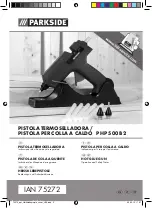
09
08
HTTP://WWW.NUMAXTOOLS.COM 1-888-669-5672
HTTP://WWW.NUMAXTOOLS.COM 1-888-669-5672
MODEL: SFR2890
MODEL: SFR2890
UNLOADING FASTENERS
Unloading is the reverse of loading, except
always disconnect the tool from the air source
before unloading.
Always unload all fasteners before
removing the tool from service.
WARNING:
!
Always disconnect the air source before
unloading.
WARNING:
!
CLEARING JAMS
Occasionally, a fastener may become jammed
in the firing mechanism of the tool, making the
tool inoperable. To remove a jammed fastener,
follow these
steps below:
Disconnect the tool from
air source.
Remove fasteners from the tool. Failure to
do so will cause the fasteners to eject from
the front of the tool.
Pull the jammed fastener out from the nose,
use pliers or
a flat-h
e
ad screwdriver if
required
to
clear
t
he
jammed
fastener
.
Using
caution
not
to
bend
or
damage
the
drive
blade
.
Reconnect the tool to the air source.
Reload the tool with fasteners
.
Make sure there are no fasteners in the
magazine before clearing a jam.
WARNING:
!
NON-MARRING PAD
The non-marring pad attached the nose of the
tool helps prevent marring and denting when
working with softer woods.
Disconnect the tool from the air source
before removing or replacing the
n-
no
marring pad or replacing the
n-marring
no
pad. Failure to do so could result in serious
personal injury.
WARNING:
!
Disconnect the tool from the air source
w h e n e v e r c l e a r i n g a j a m . A f t e r
disconnecting the tool from the air
compressor, there should still be enough
air pressure to fire the tool. After the air
hose is disconnected, always fire the tool
into scrap wood repeatedly to make sure
all of the compressed air is expended.
WARNING:
!
SETTING THE AIR PRESSURE
The amount of air pressure required depends
on the size of the fasteners and the workpiece
material.
Begin testing the depth of drive by driving a test
nail into the same type of workpiece material
used for the actual job.
Drive a test fastener with the air pressure set at
90-95 psi. Raise or lower the air pressure to find
the lowest setting that will perform the job with
consistent results.
It may be possible to achieve the desired depth
with air pressure adjustments alone.
DEPTH ADJUSTMENT
The driving depth of the fasteners are
adjustable. To adjust the depth, use the drive
depth adjustment wheel(D
)
on the tool.
Disconnect the tool from the air source.
Turn the depth wheel left or right to change
the driving depth.
Reconnect the tool to the air source.
Drive a test nail after each adjustment until
the desired depth is set.
Turn the adjustment knob clockwise
Turn the adjustment knob count clockwise
Too Deep
Adjustment
wheel
(D)
Flush
Flush
Too Shallow
Adjustment
wheel
(D)
It is advisable to test the depth on a scrap
workpiece to determine the required
depth for the application.
To determine depth of drive, first adjust
the air pressure and drive a test fastener.
Never exceed 115 psi.
CAUTION:
FIRING THE TOOL
(USING THE SELECTABLE TRIGGER)
The tool is equipped with a selectable trigger
set in the single sequential actuation
mode(black trigger). The selectable trigger(red
trigger) can also be set for contact actuation
mode.
This action mode is factory preset.
Connect the tool to the air source.
Grip the tool firmly to maintain control.
Position the nose of the tool onto the work
surface.
Squeeze the trigger to drive a fastener.
The work contact element must be
completely depressed by placing the nose
of the tool against the work piece.
The trigger must be pulled firmly and then
released.
The tool must be allowed to recoil away
from the work piece.
Disconnect the tool from the air source.
Remove the o-ring from the trigger pin (E).
Pull the trigger pin (E) out.
Put the RED trigger on.
Push the trigger pin (E) back, using a small
hammer if necessary.
Put the o-ring back to fasten the trigger pin
(E).
Connect tools to the air source.
Pull and hold the trigger with the tool off the
work piece.
Press the work contact element against the
work piece. A nail will be driven.
The tool must be allowed to recoil away
from the work piece.
Move the tool along the work piece with a
bouncing motion. Each time the work
contact element is depressed a nail will be
driven.
As soon as the desired number of nails has
been driven, remove the finger from trigger.
CONTACT ACTUATION MODE
Contact actuation allows very fast repetitive
fastener placement.
To use the tool to drive nails in this actuation
mode the work contact element and trigger can
be actuated in any order.
Single
sequential
actuation
provides
the
most
accurate
fastener
placement
.
This is
considered to be more restrictive mode of
operation, suitable for less experienced users.
To use the tool to drive nails in this actuation
mode, work contact element and trigger must
be used in a specific order.
SINGLE SEQUENTIAL ACTUATION MODE
(This firing mode is preset by factory)
1.
2.
3.
4.
5.
1.
2.
3.
4.
1.
2.
3.
4.
5.
6.
7.
1.
2.
3.
4.
5.
6.
7.
8.
9.
10.
11.
12.
Trigger pin (E)

























